|
|
|
Sort Order |
|
|
|
Items / Page
|
|
|
|
|
|
|
| Srl | Item |
| 1 |
ID:
166892
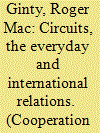

|
|
|
|
|
| Summary/Abstract |
The primary aim of this article is methodological. It proposes circuitry as an analytical device – not a mere metaphor – as a way of connecting the everyday and the hyper-local to the national, international, transnational and all levels in between. Thus, the article is concerned with international relations’ perennial levels of analysis problem. The study is prompted by empirical research from the Everyday Peace Indicators project in which research subjects narrated their own (in)security in terms of the home and the immediate vicinity of the home. The home can be regarded as a key part of everyday and ontological security for many people, but how do we connect this to the international and transnational? The article draws on the literature on engineered and biological circuits in order to propose a novel analytical device with which to emphasise the connectivity between apparently unconnected levels. A life history is used to illustrate how the analytical device might be operationalised.
|
|
|
|
|
|
|
|
|
|
|
|
|
|
|
|
| 2 |
ID:
166894
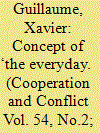

|
|
|
|
|
| Summary/Abstract |
Against the background of a continuing interest in the everyday in international relations, this article asks what kind of analytics upon and within the world mobilises one through the concept of the everyday and what consequences this may have for thinking about politics. In particular, it explores a conception of the the everyday that foregrounds the abundance of human life and ephemeral temporalities. The abundance of life invites a densification of politics combined with an emphasis on displacing levels or scales by associative horizontal relations. The ephemeral introduces a conception of temporality that foregrounds the political significance of fleeting practices and the emergent nature of life. When applied to politics, this conception of the everyday performs politics as emergent, as possibilities that are not already defined by fixing what politics can possibly be. The order of politics is then understood as an immanently precarious succession of situations and practices in which lived political lives remain inherently aleatory, momentary and emergent rather than as an order of mastering the political. The concept of the everyday, thus draws attention to the immanent elusiveness and fragility of politics as it loses its ground, its referent.
|
|
|
|
|
|
|
|
|
|
|
|
|
|
|
|
| 3 |
ID:
166887
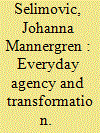

|
|
|
|
|
| Summary/Abstract |
How do we identify and understand transformative agency in the quotidian that is not contained in formal, or even informal structures? This article investigates the ordinary agency of Palestinian inhabitants in the violent context of the divided city of Jerusalem. Through a close reading of three ethnographic moments I identify creative micropractices of negotiating the separation barrier that slices through the city. To conduct this analytical work I propose a conceptual grid of place, body and story through which the everyday can be grasped, accessed and understood. ‘Place’ encompasses the understanding that the everyday is always located and grounded in materiality; ‘body’ takes into account the embodied experience of subjects moving through this place; and ‘story’ refers to the narrative work conducted by human beings in order to make sense of our place in the world. I argue that people can engage in actions that function both as coping mechanisms (and may even support the upholding of status quo), and as moments of formulating and enacting agential projects with a more or less intentional transformative purpose. This insight is key to understanding the generative capacity of everyday agency and its importance for the macropolitics of peace and conflict.
|
|
|
|
|
|
|
|
|
|
|
|
|
|
|
|
| 4 |
ID:
166886
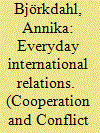

|
|
|
| 5 |
ID:
166888
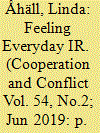

|
|
|
|
|
| Summary/Abstract |
This article explores affective, embodied encounters between military and civilian bodies in the everyday as choreography of war. It argues that by paying attention to the intersecting political sphere of bodies, affect and movement – through the metaphor of ‘dance’ – we are not only able to understand how security operates as a logic reproducing the militarisation of the everyday, but also able to identify a representational gap, an aesthetic politics, potentially useful for resistance to such practices normalising war in the everyday. It draws on two British examples of where military moves disrupt civilian spaces in the everyday: an arts project commemorating the Battle of the Somme, and a football game taking place during Remembrance week. Through embodied choreographies of war in the everyday, dance is used as a metaphor to understand militarisation as an example of feeling Everyday IR. Thus, dance is useful to ‘see’ the politics of Everyday IR, but also to understand, to feel and possibly to resist the politics of normalisation of war in the everyday. This is one example of how feeling Everyday IR offers alternative openings into political puzzles of security logics informing war as practice.
|
|
|
|
|
|
|
|
|
|
|
|
|
|
|
|
| 6 |
ID:
166891
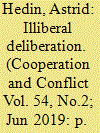

|
|
|
|
|
| Summary/Abstract |
Much social theory takes for granted that transnational people-to-people dialogue is inherently liberal in process and content – a haven of everyday authenticity that shelters ideas of human rights and democratic reform. In contrast, this contribution shows how communist regimes built and institutionalised an encompassing administrative state capacity to control and shape micro-level professional contacts with the West. This extensive but secret system of coercion, which was brought to light only with the opening of former communist regime archives, set a markedly illiberal framework for everyday East–West deliberations during the Cold War. Effectively, the travel cadre system may not only have delayed the demise of Soviet bloc communism, by isolating the population from Western influences. It was also intended to serve as a vehicle for the discursive influence of Soviet type regimes on the West. The article provides one of the first and most detailed English language maps of the administrative routines of a communist regime travel cadre system, based on the East German example. Furthermore, drawing on social mechanisms methodology, the article sets up a micro-level ‘how it could work’ scheme over how travel cadre systems can be understood as a state capacity, unique to totalitarian regimes, to help sway political discourse in open societies.
|
|
|
|
|
|
|
|
|
|
|
|
|
|
|
|
| 7 |
ID:
166889
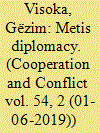

|
|
|
|
|
| Summary/Abstract |
How do emerging states obtain international recognition and secure membership of international organizations in contemporary world politics? Using the concept of ‘metis’, this article explores the role of everyday prudent and situated discourses, diplomatic performances and entanglements in the enactment of sovereign statehood and the overcoming of external contestation. To this end, it describes Kosovo’s diplomatic approach to becoming a sovereign state by obtaining international recognition and securing membership of international organizations. Drawing on institutional ethnographic research and first-hand observations, the article argues that Kosovo’s success in consolidating its sovereign statehood has been the situational assemblage of multiple discourses, practiced through a broad variety of performative actions and shaped by a complex entanglement with global assemblages of norms, actors, relations and events. Accordingly, this study contributes to the conceptualization of the everyday in diplomatic practice by offering an account of how micro-practices feed into macro-practices in world politics.
|
|
|
|
|
|
|
|
|
|
|
|
|
|
|
|
| 8 |
ID:
166895
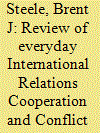

|
|
|
|
|
| Summary/Abstract |
The following include reviews of the special issue contributions, and in some cases reviews of the resubmissions.
|
|
|
|
|
|
|
|
|
|
|
|
|
|
|
|
| 9 |
ID:
166890
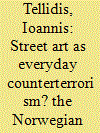

|
|
|
|
|
| Summary/Abstract |
This article looks at a project involving nine internationally acclaimed street artists who agreed to make murals in Oslo, following the 22 July 2011 attacks. Resting on the art project’s aims (‘to promote universal human rights and to counter the intolerance and xenophobia that can give rise to violence and justify terrorism’) and the art community’s reaction, the article argues that street art’s visibility and agency offer alternative ways of thinking about, and approaching, international relations (IR). The article examines the streets as the space where artists express and engage the ‘everyday’; and as the medium that allows artists to bring art to the public (as opposed to galleries or exhibitions the public chooses to visit). We argue that the incorporation of street art’s spatiality and aesthetics into ‘everyday IR’ supports more critical frameworks that (a) expose the exceptional logic(s) of illiberal governance; (b) enable the visibility of marginalised and/or dissenting voices in society; and (c) explore experimental, eclectic and creative approaches of doing/thinking everyday security, community and peace.
|
|
|
|
|
|
|
|
|
|
|
|
|
|
|
|
| 10 |
ID:
166893
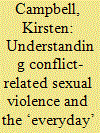

|
|
|
|
|
| Summary/Abstract |
The testimonies of witnesses who testify before criminal courts provide crucial insights into the situated experience of conflict-related sexual violence. Witness testimonies highlight the complex realities and everyday lives of individuals caught up in situations of armed conflict. The evidence presented by witnesses can provide vital insights into lived experiences of wartime violence, and reveal the seemingly mundane strategies and tactics adopted by victims to cope with, survive and resist the violent and coercive circumstances of war. This article foregrounds conflict-related sexual violence witness testimonies as highly significant sources of knowledge of everyday experiences of conflict. It sets out a bottom-up, mixed-method approach for identifying and analysing the experiential accounts of those who lived through conflict-related sexual violence, while engaging with the opportunities and challenges of using witness testimony. Our approach unsettles existing notions of ‘the everyday’ in Peace & Conflict Studies as a synonym for narratives and practices of violence, justice and peacebuilding that are private, informal and largely hidden from view. Understanding witness testimonies requires conceptualising the everyday as an amalgam of formal and informal practices, as accessible through both elite and lay knowledges and as documented in both public and private (e.g. redacted) sources. It requires challenging taken-for-granted dichotomies that are frequently invoked to understand conflict and peace.
|
|
|
|
|
|
|
|
|
|
|
|
|
|
|
|
|
|
|
|
|